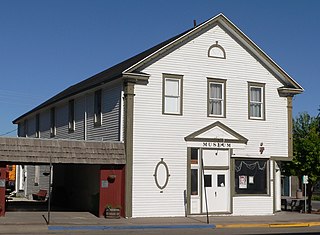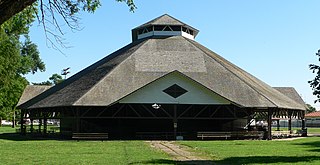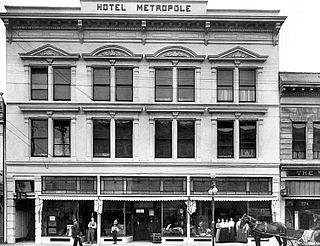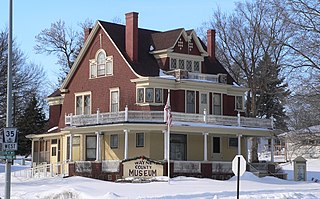
The Cook Blacksmith Shop is a former blacksmith shop in Ponca, Nebraska, United States that today is a museum.

The Z.C.B.J. Rad Tabor No. 74, also known as Tabor Hall, is an historic building located south of Dorchester in rural Saline County, Nebraska. It was built in 1914; a large dance pavilion was added in 1934. It was listed on the National Register of Historic Places on August 23, 1985. It historically served as a meeting hall for the Czech community, hosting Czech language classes and Sokol events.

St. Benedict's Catholic Church is a Catholic church in Nebraska City, Nebraska, United States. It is on the National Register of Historic Places. The church parish was founded in 1856 and its building, completed in 1861, is the oldest brick church in the state of Nebraska. The church's address is 411 5th Rue, Nebraska City, Nebraska.

The Co-operative Block Building is a commercial structure in downtown Crawford, Nebraska. It was built in 1909 and added to the National Register of Historic Places on September 12, 1985. It is also known locally as Co-op Block, Midwest Block, or The Broken Spur, after the business that it currently houses.

Saint Martin's Catholic Church is a Roman Catholic church building near Deweese, Nebraska. The church was built to serve a Czech immigrant congregation.

Zion Presbyterian Church is a historic church in Clarkson, Nebraska that is significant "as the first Czech Presbyterian Church in Nebraska and one of a very few in this section of the country". It was designed by a Czech architect named M.D. Flechor and was built during 1887–88.

The Hotel DeFair, at NE 2 and Main St. in Hyannis, Nebraska, and also known as the Hyannis Hotel, was built in 1898 and is listed on the National Register of Historic Places (NRHP). According to its NRHP nomination, it once was considered to be the best hotel and restaurant in western Nebraska.

The Fraternal Hall, at 2nd and Chestnut Sts. in Kimball, Nebraska, was built in 1903–04. It includes Classical Revival architecture. It is now operated as Plains Historical Museum.

The Chautauqua Pavilion is an octagonal pavilion located in Chautauqua Park in Hastings, Nebraska. The pavilion was constructed in 1907 for summer Chautauqua assemblies in Hastings. According to the Historic American Engineering Record, the pavilion's design is unique; in fact, the HAER does not have a name for certain design elements used in the pavilion. The building's pyramidal roof is supported by columns along the pavilion's perimeter; a triangular truss atop the columns acts as the pavilion's superstructure. A vent at the top of the roof is supported by a Howe truss. A stage and orchestra pit are located inside the pavilion, though the majority of the space inside the pavilion is open, allowing a variety of activities to be held there. The Hastings chapter of the Chautauqua movement held independent assemblies at the pavilion until 1913, when it merged with the national movement. Hastings continued to host Chautauqua events until the 1920s, when the movement declined due to the rise of film and radio.

The Garfield County Frontier Fairgrounds, near Burwell, Nebraska, also known as Burwell Rodeo Ground, is a historic property with significance dating to 1922. A 40-acre (16 ha) area was listed as a historic district on the U.S. National Register of Historic Places in 1985. The listing included 13 contributing buildings and seven other contributing structures.

The Hotel Metropole, built in 1908, was added to the National Register of Historical Places in 1979. It was demolished after being severely damaged in the 1989 Loma Prieta earthquake.

The Dr. W. C. Wightman House in Wayne, Nebraska was built in Shingle Style in 1900. Also known as the Rollie W. Ley House and as the Wightman-Ley House, it is a two-and-a-half-story house with a large porch around two sides of its first story. It was listed on the National Register of Historic Places in 1978.

The Liederkranz hall is a historic building in Grand Island, Nebraska. It was built in 1911-1912 for the local Liederkranz, or German-language choir, founded in 1870. Moreover, "All meetings, programs, etc. were conducted in German until World War I when English became the official language" of the hall. The building was designed in the Classical Revival style by architect Oscar Kirche. It has been listed on the National Register of Historic Places since November 30, 1978. It is the only Liederkranz in Nebraska.

The John Cattle Jr. House is a historic house in Seward, Nebraska. It was built in 1885 for John Cattle Jr., an English immigrant and co-founder of the State Bank of Nebraska. Cattle lived here with his wife Blanche, a Welsh immigrant. It was designed in the Second Empire architectural style. It has been listed on the National Register of Historic Places since September 13, 1978.

The Mann-Zwonecek House is a historic house in Wilber, Nebraska. It was built in 1881 for businessman William H. Mann, and designed in the Italianate and Second Empire architectural styles. It belonged to the Zwonecek family from 1894 to 1968. By the 1970s, it was "the only extant home of imposing grandeur in Wilber dating to the early 1880s." It has been listed on the National Register of Historic Places since December 29, 1978.

The Jesse C. Bickle House, also known as The Maples, is a historic house in Crete, Nebraska. It was built by homesteader Jesse C. Bickle as a one-story log house in 1864, and a second story was added in the 1870s. Bickle owned a brickyard in Crete and a store in Pleasant Hill. The house was designed in the Carpenter Gothic architectural style. It was purchased by Milton O. Smith in 1923, and renamed The Maples. It has been listed on the National Register of Historic Places since November 23, 1977.

Boscobel is a historic two-story house in Nebraska City, Nebraska. It was built in 1879 for Rollin M. Rolfe, a grocer, banker and co-founder of the Midland Pacific Railway who served on Nebraska City's city council as a Republican in 1873. The house was designed in the Italianate style, with "paneled and bracketed cornice" and "stone quoins." Rolfe moved out of the house in 1886. It has been listed on the National Register of Historic Places since June 17, 1976.

The Thomas J. Majors Farmstead is a historic estate with a two-story house in Peru, Nebraska. The house was built in 1898 for Thomas Jefferson Majors, after he had served as a member of the United States House of Representatives from 1878 to 1879, and as Nebraska's lieutenant governor from 1891 to 1895. The house has been listed on the National Register of Historic Places since June 15, 1978.

The Johnston Memorial Building is a historic building in Wallace, Nebraska. It was built in 1921 in memory of John R. Johnston, the founder of the Johnston Brokerage Company, a Pittsburgh, Pennsylvania-based window glass manufacturing company, who vacationed in Wallace. The building was designed in a "pleasing" combination of Prairie School and Craftsman styles by noted architect Francis W. Fitzpatrick. It was built by McMichael Bros. It has been listed on the National Register of Historic Places since March 20, 1986.

The Keystone Community Church, on McGinley St. in Keystone, Nebraska, was built in 1908. It was listed on the National Register of Historic Places in 1979.






















